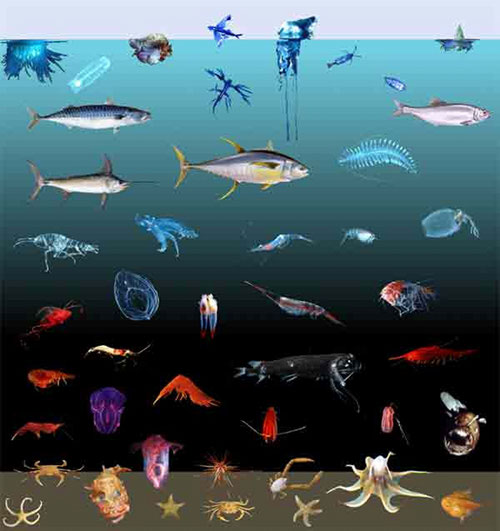How does depth affect the color of marine animals?
The coloration of animals in the ocean follows a surprisingly regular pattern by depth, most likely tied to how light penetrates ocean water and an animal's ability to blend in with its surroundings.

The coloration of oceanic animals, shown as a function of depth. Download image (jpg, 49 KB).
Unlike animals on land or in shallow water – where skin, fur, and feather coloration may differ within habitats like hues on an artist's palette – deep-sea animals follow a surprisingly regular pattern in their coloration. Blue animals in the ocean live near the surface. Slightly deeper down, animals are blue on top and white on the bottom. At even greater depths, animals are generally transparent, but have red stomachs. Below that, animals are red or black over their entire bodies. Finally, at the bottom, almost all animals are either a pale red or a cream color. The most likely explanation for this distribution is camouflage (color that blends in with the surroundings).
For an animal to be invisible, its color and brightness have to match that of the background. Unfortunately for the animal, its color also depends on the light hitting it. For example, a white piece of paper looks red under red light, and blue under blue light. In our normal day, the changes in the color of the surrounding light have a big effect on the color of the objects we see.
Each color of our visible spectrum has a specific wavelength; as wavelength decreases from red to blue light, so does the ability of light to penetrate water. Blue light penetrates best, green light is second, yellow light is third, followed by orange light and red light. Red light is quickly filtered from water as depth increases and red light effectively never reaches the deep ocean, meaning animals that live in deep water and are red are essentially invisible.
An animal that relies on color for camouflage has to worry both about the color of the background and the color of the surrounding light. For animals living on the seafloor, the background and the animal are illuminated by the same light, so the animal doesn't have an issue. Animals swimming in the water do, though, because the background light isn't affected by the surrounding light in a simple way. Scientists are still learning about the "tricks" that marine animals use to camouflage themselves.